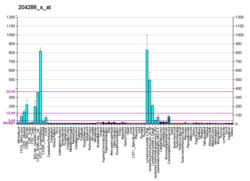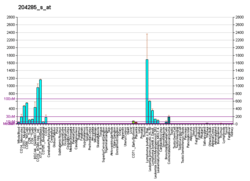Phorbol-12-myristate-13-acetate-induced protein 1
Phorbol-12-myristate-13-acetate-induced protein 1 is a protein that in humans is encoded by the PMAIP1 gene, and is also known as Noxa.[3][4][5]
Noxa (Latin for damage) is a pro-apoptotic member of the Bcl-2 protein family.[6] Bcl-2 family members can form hetero- or homodimers, and they act as anti- or pro-apoptotic regulators that are involved in a wide variety of cellular activities. The expression of Noxa is regulated by the tumor suppressor p53, and Noxa has been shown to be involved in p53-mediated apoptosis.
Interactions
Noxa has been shown to interact with:
gollark: WEB APPLICATION FIREWALL
gollark: yes.
gollark: I'm sure nobody or palaiologos or someone will eventually complain that C is not an unfathomable nightmarish hellscape and its wild unsafety is fine because just don't make mistakes.
gollark: The actual LLVM *language* isn't, even if it's implemented in it.
gollark: C is older and people program in it *directly* sometimes.
See also
- Apoptosis
- Apoptosome
- Bcl-2
- Bcl-2-associated X protein (BAX)
- BH3 interacting domain death agonist (BID)
- Caspases
- Cytochrome c
- Mitochondrion
- p53 upregulated modulator of apoptosis (PUMA)
- 12-O-Tetradecanoylphorbol-13-acetate (Phorbol-12-myristate-13-acetate)
References
- GRCh38: Ensembl release 89: ENSG00000141682 - Ensembl, May 2017
- "Human PubMed Reference:". National Center for Biotechnology Information, U.S. National Library of Medicine.
- Hijikata M, Kato N, Sato T, Kagami Y, Shimotohno K (October 1990). "Molecular cloning and characterization of a cDNA for a novel phorbol-12-myristate-13-acetate-responsive gene that is highly expressed in an adult T-cell leukemia cell line". J Virol. 64 (10): 4632–9. PMC 247947. PMID 2398525.
- Jansson AK, Emterling AM, Arbman G, Sun XF (July 2003). "Noxa in colorectal cancer: a study on DNA, mRNA and protein expression". Oncogene. 22 (30): 4675–8. doi:10.1038/sj.onc.1206655. PMID 12879012.
- "Entrez Gene: PMAIP1 phorbol-12-myristate-13-acetate-induced protein 1".
- Oda E, Ohki R, Murasawa H, Nemoto J, Shibue T, Yamashita T, Tokino T, Taniguchi T, Tanaka N (May 2000). "Noxa, a BH3-only member of the Bcl-2 family and candidate mediator of p53-induced apoptosis". Science. 288 (5468): 1053–1058. doi:10.1126/science.288.5468.1053. PMID 10807576.
- Chen L, Willis SN, Wei A, Smith BJ, Fletcher JI, Hinds MG, Colman PM, Day CL, Adams JM, Huang DC (February 2005). "Differential targeting of prosurvival Bcl-2 proteins by their BH3-only ligands allows complementary apoptotic function". Mol. Cell. 17 (3): 393–403. doi:10.1016/j.molcel.2004.12.030. PMID 15694340.
- Oda E, Ohki R, Murasawa H, Nemoto J, Shibue T, Yamashita T, Tokino T, Taniguchi T, Tanaka N (May 2000). "Noxa, a BH3-only member of the Bcl-2 family and candidate mediator of p53-induced apoptosis". Science. 288 (5468): 1053–8. doi:10.1126/science.288.5468.1053. PMID 10807576.
- Willis SN, Chen L, Dewson G, Wei A, Naik E, Fletcher JI, Adams JM, Huang DC (June 2005). "Proapoptotic Bak is sequestered by Mcl-1 and Bcl-xL, but not Bcl-2, until displaced by BH3-only proteins". Genes Dev. 19 (11): 1294–305. doi:10.1101/gad.1304105. PMC 1142553. PMID 15901672.
Further reading
- Oda E, Ohki R, Murasawa H, Nemoto J, Shibue T, Yamashita T, Tokino T, Taniguchi T, Tanaka N (2000). "Noxa, a BH3-only member of the Bcl-2 family and candidate mediator of p53-induced apoptosis". Science. 288 (5468): 1053–8. doi:10.1126/science.288.5468.1053. PMID 10807576.
- Seo YW, Shin JN, Ko KH, Cha JH, Park JY, Lee BR, Yun CW, Kim YM, Seol DW, Kim DW, Yin XM, Kim TH (2004). "The molecular mechanism of Noxa-induced mitochondrial dysfunction in p53-mediated cell death". J. Biol. Chem. 278 (48): 48292–9. doi:10.1074/jbc.M308785200. PMID 14500711.
- Kim JY, Ahn HJ, Ryu JH, Suk K, Park JH (2004). "BH3-only protein Noxa is a mediator of hypoxic cell death induced by hypoxia-inducible factor 1alpha". J. Exp. Med. 199 (1): 113–24. doi:10.1084/jem.20030613. PMC 1887730. PMID 14699081.
- Yakovlev AG, Di Giovanni S, Wang G, Liu W, Stoica B, Faden AI (2004). "BOK and NOXA are essential mediators of p53-dependent apoptosis". J. Biol. Chem. 279 (27): 28367–74. doi:10.1074/jbc.M313526200. PMID 15102863.
- Qin JZ, Stennett L, Bacon P, Bodner B, Hendrix MJ, Seftor RE, Seftor EA, Margaryan NV, Pollock PM, Curtis A, Trent JM, Bennett F, Miele L, Nickoloff BJ (2005). "p53-independent NOXA induction overcomes apoptotic resistance of malignant melanomas". Mol. Cancer Ther. 3 (8): 895–902. PMID 15299072.
- Flinterman M, Guelen L, Ezzati-Nik S, Killick R, Melino G, Tominaga K, Mymryk JS, Gäken J, Tavassoli M (2005). "E1A activates transcription of p73 and Noxa to induce apoptosis". J. Biol. Chem. 280 (7): 5945–59. doi:10.1074/jbc.M406661200. PMID 15572378.
- Chen L, Willis SN, Wei A, Smith BJ, Fletcher JI, Hinds MG, Colman PM, Day CL, Adams JM, Huang DC (2005). "Differential targeting of prosurvival Bcl-2 proteins by their BH3-only ligands allows complementary apoptotic function". Mol. Cell. 17 (3): 393–403. doi:10.1016/j.molcel.2004.12.030. PMID 15694340.
- Sun Y, Leaman DW (2005). "Involvement of Noxa in cellular apoptotic responses to interferon, double-stranded RNA, and virus infection". J. Biol. Chem. 280 (16): 15561–8. doi:10.1074/jbc.M412630200. PMID 15705586.
- Ceballos E, Muñoz-Alonso MJ, Berwanger B, Acosta JC, Hernández R, Krause M, Hartmann O, Eilers M, León J (2005). "Inhibitory effect of c-Myc on p53-induced apoptosis in leukemia cells. Microarray analysis reveals defective induction of p53 target genes and upregulation of chaperone genes". Oncogene. 24 (28): 4559–71. doi:10.1038/sj.onc.1208652. PMID 15856024.
- Willis SN, Chen L, Dewson G, Wei A, Naik E, Fletcher JI, Adams JM, Huang DC (2005). "Proapoptotic Bak is sequestered by Mcl-1 and Bcl-xL, but not Bcl-2, until displaced by BH3-only proteins". Genes Dev. 19 (11): 1294–305. doi:10.1101/gad.1304105. PMC 1142553. PMID 15901672.
- Alves NL, Derks IA, Berk E, Spijker R, van Lier RA, Eldering E (2006). "The Noxa/Mcl-1 axis regulates susceptibility to apoptosis under glucose limitation in dividing T cells". Immunity. 24 (6): 703–16. doi:10.1016/j.immuni.2006.03.018. PMID 16782027.
- Obexer P, Geiger K, Ambros PF, Meister B, Ausserlechner MJ (2007). "FKHRL1-mediated expression of Noxa and Bim induces apoptosis via the mitochondria in neuroblastoma cells". Cell Death Differ. 14 (3): 534–47. doi:10.1038/sj.cdd.4402017. PMID 16888645.
- Fribley AM, Evenchik B, Zeng Q, Park BK, Guan JY, Zhang H, Hale TJ, Soengas MS, Kaufman RJ, Wang CY (2006). "Proteasome inhibitor PS-341 induces apoptosis in cisplatin-resistant squamous cell carcinoma cells by induction of Noxa". J. Biol. Chem. 281 (42): 31440–7. doi:10.1074/jbc.M604356200. PMID 16928686.
- Smit LA, Hallaert DY, Spijker R, de Goeij B, Jaspers A, Kater AP, van Oers MH, van Noesel CJ, Eldering E (2007). "Differential Noxa/Mcl-1 balance in peripheral versus lymph node chronic lymphocytic leukemia cells correlates with survival capacity". Blood. 109 (4): 1660–8. doi:10.1182/blood-2006-05-021683. PMID 17038534.
- Armstrong JL, Veal GJ, Redfern CP, Lovat PE (2007). "Role of Noxa in p53-independent fenretinide-induced apoptosis of neuroectodermal tumours". Apoptosis. 12 (3): 613–22. doi:10.1007/s10495-006-0020-1. PMID 17216584.
External links
- NOXA+protein,+human at the US National Library of Medicine Medical Subject Headings (MeSH)
This article is issued from Wikipedia. The text is licensed under Creative Commons - Attribution - Sharealike. Additional terms may apply for the media files.



